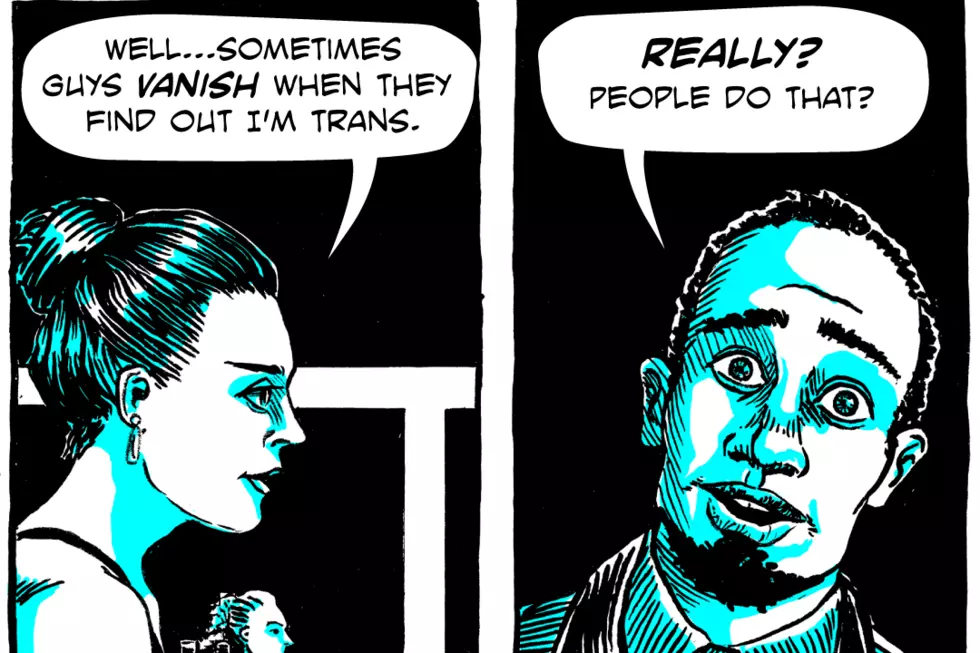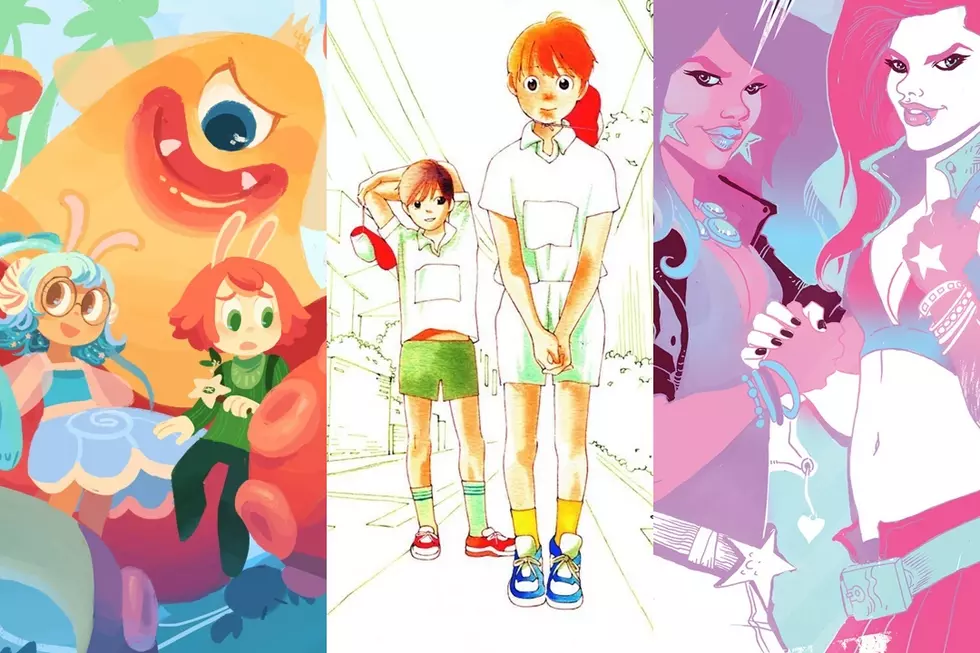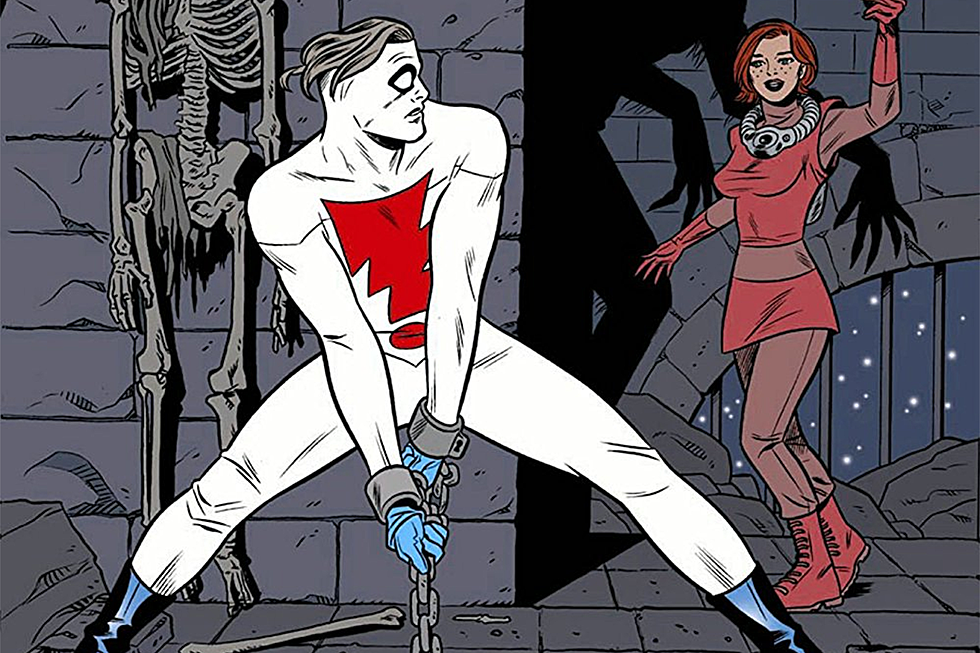
Welcome to Wet Moon: Revisiting Sophie Campbell’s Graphic Novel Series
Let me put my cards on the table: Sophie Campbell is my favorite comic book artist. She has been at least since the Glory series she did with Joe Keatinge, although I was a fan of her work even before that. I was thrilled when her Jem and Holograms series with Kelly Thompson was announced, and it’s one of my very favorite things on the stands right now.
But my favorite comics work she’s done is Wet Moon, a series of graphic novels from Oni Press, which has been ongoing for over a decade. In Wet Moon, Campbell weaves realism with subtle fantasy and horror elements, and follows a large cast of distinct characters. There are six books currently out, and Campbell has said there are at least two more to come.
Wet Moon starts out solidly in “slice of life” territory, following awkward goth teen Cleo Lovedrop as she moves into an apartment and begins her freshman year at a Southern art school. Cleo’s a townie, attending college in the same small town of Wet Moon where her family still lives. Her best friends since childhood, Trilby and Mara, are at the school too, although they’re not rooming together (which is probably for the best, because the three of them mostly bicker at this point). Instead, Cleo rooms with Natalie, who seems mean but may just be shy, and Malady, who always carries pie in her bag.
But from the very beginning, something seems a little creepy, a little off. The setting epitomizes Southern Gothic in the most literal sense—a swamp town of twisting trees, Spanish moss, and rumored giant animals. The girl who used to live in Cleo’s room mysteriously vanished, leaving only a strange round spot on the floor. Unusual people lurk around town: A well-dressed man with an ever-present monkey, an unhealthy-looking girl who almost mirrors the mummy girl from Campbell’s Shadoweyes, and Fern, a bald and unusual-looking young heiress who seems to know more about everyone than she should.
And the only art anyone at this art school seems to produce is of monsters and demons. Except for Zia, who takes pictures of herself lying in mud puddles and trash heaps.
Queerness permeates the book from the beginning, and only becomes more central as the story proceeds. Cleo’s friend Audrey is an out lesbian from the beginning (although not to her parents, yet). Cleo has a brief romantic interest in her friend Glenn, but he turns out to be gay. Trilby tries to kiss Cleo after a night of drinking, leading to a lot of awkwardness. But then Cleo meets a girl named Myrtle, and realizes she’s queer too.
Myrtle is central to what’s strange in Wet Moon. She’s sweet to Cleo at first, but it quickly becomes clear that there’s something dark inside her. Sublimated anger and self-loathing definitely, but possibly something more than that? She keeps talking about werewolves, and is seen examining her canine teeth in the mirror. She walks the streets alone at night, thinking vicious thoughts about the women she passes and sometimes carrying a knife. It’s clear very early on that whatever’s coiled up inside of Myrtle is going to strike. It does, more than once by Book Six, but there’s still a lot we haven’t learned about what her true nature is.
The town of Wet Moon also has a makeshift superhero, in the form of the masked vigilante known as Unknown. Her identity has yet to be revealed, but if she’s a member of the main cast Campbell has done a very good job of keeping readers from recognizing her. Unknown wears a balaclava and wields a wooden sword. She only appears when a crime is being committed, at least until the end of Book Six, when she knocks on a door for reasons that won’t be made clear until future volumes.
And then there’s Fern. She lives in a haunted-looking mansion on the edge of town, the last living member of her very wealthy family. She’s very small and appears to have hypohidrotic ectodermal dysplasia or a similar condition. She also has very poor eyesight and one shorter arm with an ectrodactylous hand. There are hints that there might be inbreeding in her family history, but it’s never been directly addressed. Fern employs Cleo’s older sister Penny as a decorator, and also might be in love with her, although that’s still a bit of a mystery as well. The biggest mystery, however, is what she gets out of hanging upside down by her ankles, and crawling naked through the swamp.
Fern’s not the only disabled character in Wet Moon. As in her other work, Sophie Campbell is actively interested in depicting people with all kinds of bodies that work in all kinds of ways. Cleo has a heart condition, Zia is an amputee, and Glen lives with a chronic stomach illness.
The series’ body diversity doesn’t stop at disability. Cleo is a young woman of size, as are Myrtle, Audrey, and several other characters. Of the four leads, only Trilby is thin, and she’s depicted as gangly and awkward rather than idealized. Two out of those four (Audrey and Mara) are also black, and other characters of color are spread throughout the cast.
Campbell is a creator who obviously puts deliberate effort into making her characters diverse, and contrary to the warnings of regressive alarmists throughout comics culture, nothing about that feels forced or unnatural. The world of Wet Moon is one where strange things happen, but it’s also a world populated by the same wide variety of people that fill our world, and that makes it feel real.
Because this series began in 2004, Campbell’s progression as an artist is visible from volume to volume. She’s already very good in Book One, but she’s a million times better by Book Six. In the early books, some of the characters look a little too similar, and none of the character designs are as visually appealing as they eventually become. The lines are also thinner and less assured early on, and the lettering is much shakier.
There’s a noticeable jump forward in the art between Books One and Two, and another leap after that. In Book Three, Campbell is suddenly unafraid to exaggerate her characters’ features, which makes them look far more distinctive and interesting. This shift is particularly embodied in Cleo’s huge eyes, as well as Audrey’s lips and Natalie’s nose. Some changes in appearance are noted in the story, such as Audrey letting her hair go natural, and Mara abandoning her somewhat exaggerated goth-punk aesthetic for a casual butch style.
Campbell’s writing also evolves as the story goes along. In the first couple of books, Cleo, Trilby, and Mara bicker and yell at each other constantly to a degree that’s tiring just to read. They feel like real 18-year-olds, to be sure, but that doesn’t make them likable. As the series goes on, they keep the same personalities but mellow out enough to be much more readable and relatable. Also, Cleo and Mara eventually figure out some things about why it was hard for them to get along.
So if you’re looking to check out Wet Moon, I think it might not be a bad idea to start with Book Three, and then go back to the first two books once you’re into the series. But if you are a stickler for starting stories at the beginning, at least keep in mind that things evolve pretty quickly from Book One. Personally, I started at Book Six, because it was the first one available on Comixology (the earlier volumes have since been added). I had no problem engaging with that book without reading the previous five, but it did spoil some twists so I don’t recommend it.
Book Six was published in 2012, and since then Sophie Campbell has been on the rise as a more mainstream artist for books like Glory, Teenage Mutant Ninja Turtles, and of course Jem. I'm optimistic that she’ll return to Wet Moon, because it’s so obviously a labor of love, but what if she doesn’t? It’s something I’ve thought about as a fan of the series, because no artist has infinite time, and she’s doing such great work on other things these days.
The conclusion I’ve reached is that Wet Moon is already a masterpiece, even if there’s never another book. There are mysteries to be solved and monsters to be defeated, but this story has already given us so much about friendship, coming of age, and queer experiences. I want to see the story completed, but I will recommend the series as great comics even if what we have now is all there ever is.
More From ComicsAlliance








![Lost in Transition: ‘Demon Knights’, Shining Knight, And the Power of Clarity [Fantasy Week]](http://townsquare.media/site/622/files/2016/10/lostintransition-demonknigh.jpg?w=980&q=75)
